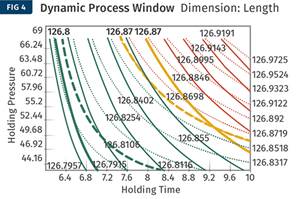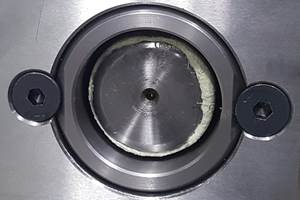Secrets of Successful Thin-Wall Molding
Demands to create smaller, lighter parts have made thin-wall molding one of the most sought after capabilities for an injection molder.
Demands to create smaller, lighter parts have made thin-wall molding one of the most sought after capabilities for an injection molder. These days, "thin-wall" is generally defined by portable electronics parts having a wall thickness less than 1 mm. For large automotive parts, "thin" may mean 2 mm. In any case, thinner wall sections bring changes in processing requirements: higher pressures and speeds, faster cooling times, and modifications to part-ejection and gating arrangements. These process changes have in turn prompted new considerations in mold, machinery, and part design.
Machinery considerations
Standard molding machinery can be used for many thin-wall applications. Capabilities built into newer standard machines go well beyond those of 10 years ago. Advances in materials, gating technology, and design further expand the capabilities of a standard machine to fill thinner parts.
But as wall thicknesses continue to shrink, a more specialized press with higher speed and pressure capabilities may be required. For example, with a portable electronics part less than 1 mm thick, fill times of less than 0.5 sec and injection pressures greater than 30,000 psi are not uncommon. Hydraulic machines designed for thin-wall molding frequently have accumulators driving both injection and clamping cycles. All-electric and hybrid electric/hydraulic models with high speed and pressure capabilities are starting to appear as well.
To stand up to the high pressures involved, clamp force should be a minimum of 5-7 tons/sq in. of projected area. In addition, extra-heavy platens help to reduce flexure as wall thicknesses drop and injection pressures rise. Thin-wall machines commonly have a 2:1 or lower ratio of tiebar distance to platen thickness. Also, with thinner walls, closed-loop control of injection speed, transfer pressure, and other process variables can help to control filling and packing at high speeds and pressures.
When it comes to shot capacity, large barrels tend to be too large. We suggest you aim for a shot size of 40% to 70% of barrel capacity. The greatly reduced total cycle time seen in thin-wall applications may make it possible to reduce the minimum shot size to 20%-30% of barrel capacity, but only if the parts are thoroughly tested for property loss due to possible material degradation. Users must be careful, as small shot sizes can mean longer barrel residence times for the material, resulting in property degradation.
Molds: make 'em rugged
Speed is one of the key attributes of successful thin-wall molding. Faster filling and higher pressures are required to drive molten thermoplastic material into thinner cavities at a sufficient rate to prevent freeze off. If a standard part is filled in 2 sec, then a reduction in thickness of 25% potentially can require a drop in fill time of 50% to just 1 sec.
One benefit of thin-wall molding is that as wall sections drop, there is less material to cool. Cycle times can drop by 50% with aggressive wall-thickness reduction. Careful management of the melt-delivery system can keep runners and sprues from diminishing that cycle-time advantage. Hot runners and heated sprue bushings are often used in thin-wall molding to help minimize cycle time.
Mold material should be reviewed too. P20 steel is used extensively in conventional applications, but due to the higher pressures of thin-wall molding, molds must be built more robustly. H-13 and other tough steels add an extra degree of safety for thin-wall tools. (If possible, you will also want to select a molding material that doesn't accelerate mold wear when injected into the cavity at high speeds.)
However, robust tools cost money—possibly even 30% to 40% more than a standard mold. Yet the cost is often offset by increased productivity. In fact, the thin-wall approach is frequently used to save money on tooling. A 100% increase in productivity can mean that fewer molds need to be built, thereby saving money over the life of a program.
Here are some more tips on tool design for thin walls:
- For aggressive thin-wall applications, use steel harder than P20, especially when high wear and erosion are expected. H-13 and D-2 steels have been successful in gate inserts.
- Mold interlocks sometimes can stave off flexing and misalignment.
- Cores that telescope into the cavity can help reduce core shifting and breakage.
- Use heavier support plates (often 2 to 3 in. thick) with support pillars (typically preloaded 0.005 in.) under the cavities and sprue.
- Use more and larger ejector pins than with conventional molds to reduce pin pushing.
- Consider strategic placement of sleeve and blade knockouts.
- No. 2 diamond polish on cores and ribs can eliminate problems of part sticking. Mold surface treatments, such as nickel-PTFE can also improve part release.
- Venting is critical and can be facilitated with vented core pins and ejector pins, as well as venting along up to 30% of the parting line around the part. Vents are typically 0.0008 to 0.0012 in. deep and 0.200 to 0.0400 in. wide. While not usually necessary, some processors have sealed the parting line with an O-ring in order to pull a vacuum on the cavity for quick gas evacuation.
- With higher injection speeds, gates larger than the nominal walls help reduce material shear and gate wear and help prevent freeze-off before good packing is achieved.
- Gate inserts with a Rockwell (Rc) hardness greater than 55 are typically used to withstand high injection pressures.
- When gating directly onto a thin wall with a sprue, pinpoint, or hot-drop, use gate wells to reduce stress at the gate, aid filling, and reduce part damage when degating.
- Hot manifolds can help reduce pressure loss in runner systems, but they require at least 0.5-in.-diam. inner passages with no sharp corners or dead zones. Manifolds should have external, not internal, heaters. Valve gates, if used, must be non-restrictive and built to take high pressure.
In addition, cooling of the cores and cavities is more critical and challenging in thin-wall applications. Two important guidelines are:
- Non-looping cooling lines should usually be located directly in the core and cavity blocks to help keep the mold surface temperature as consistent as possible.
- Instead of decreasing coolant temperature to maintain the desired steel temperature, it is generally better to increase the amount of coolant flow through the tool. As a rule of thumb, the difference in temperature between the delivery coolant and return coolant should be no more than 5° to 10° F.
|
STANDARD VS. THIN-WALL PROCESSING
|
|||
| Key Factors | Conventional | Thin-Wall | |
| Typical Wall, in. | 0.080-0.120 | 0.050-0.080 | <0.050 |
| Machinery | Standard | High-end | Custom |
| Inject. Pressure, psi | 9000-14,000 | 16,000-20,000 | 20,000-35,000 |
| Hydraulic System | Standard | Standard | Accumulators on injection & clamp units. Servo valves. |
| Control System | Standard | Closed-loop on injection speed, hold pressure, decompression speed, screw rpm, backpressure, and all temperatures. | Same as at left, with resolution of 0.40 in. on speed, 14.5 psi on pressure, 0.004 in. on position, 0.01 sec on time, 1 rpm on rotation, 0.10 ton on clamp force, 2° F on temperature. |
| Processing | |||
| Fill Time, sec | >2 | 1-2 | 0.1-1 |
| Cycle Time, sec | 40-60 | 20-40 | 6-20 |
| Tooling | Standard | Better venting, heavier construction, more ejector pins, better polish | Extreme venting, very heavy construction, mold interlocks, precise surface preparation, extensive ejection features, mold costs 30-40% higher than standard. |
Related Content
How to Mount an Injection Mold
Five industry pros with more than 200 years of combined molding experience provide step-by-step best practices on mounting a mold in a horizontal injection molding machine.
Read MoreOptimizing Pack & Hold Times for Hot-Runner & Valve-Gated Molds
Using scientific procedures will help you put an end to all that time-consuming trial and error. Part 1 of 2.
Read MoreWhat You Need to Know About Leader Pins and Bushings
There’s a lot more to these humble but essential mold components than you might suspect. Following the author’s tips could save much time, money and frustration.
Read MoreWhy Shoulder Bolts Are Too Important to Ignore (Part 1)
These humble but essential fasteners used in injection molds are known by various names and used for a number of purposes.
Read MoreRead Next
Processor Turns to AI to Help Keep Machines Humming
At captive processor McConkey, a new generation of artificial intelligence models, highlighted by ChatGPT, is helping it wade through the shortage of skilled labor and keep its production lines churning out good parts.
Read MoreAdvanced Recycling: Beyond Pyrolysis
Consumer-product brand owners increasingly see advanced chemical recycling as a necessary complement to mechanical recycling if they are to meet ambitious goals for a circular economy in the next decade. Dozens of technology providers are developing new technologies to overcome the limitations of existing pyrolysis methods and to commercialize various alternative approaches to chemical recycling of plastics.
Read MoreWhy (and What) You Need to Dry
Other than polyolefins, almost every other polymer exhibits some level of polarity and therefore can absorb a certain amount of moisture from the atmosphere. Here’s a look at some of these materials, and what needs to be done to dry them.
Read More





























